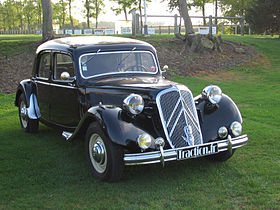Traction Avant
| Citroën Traction Avant | |
|---|---|
 |
|
| Overview | |
| Manufacturer | Citroën |
| Also called | Citroën 7CV Citroën 11CV Citroën 15CV Citroën Light 15 (UK) Citroën Big Fifteen (UK) Citroën Big Six (UK) |
| Production | 7 CV 1934–41 11CV 1934–57 15CV 1938–56 |
| Assembly |
Paris, France Vorst, Belgium Cologne, Germany Slough, England Copenhagen, Denmark |
| Designer |
Flaminio Bertoni André Lefèbvre |
| Body and chassis | |
| Class | Executive car (E) |
| Body style | 4-door saloon 2-door saloon 2-door convertible 5-door hatchback |
| Layout | MF layout |
| Related | Citroën H Van |
| Powertrain | |
| Engine | 1.3 / 1.5 / 1.6 / 1.9 L I4 2.9 L I6 |
| Transmission | 3-speed manual, column/dash shift |
| Dimensions | |
| Wheelbase | 2,910 mm (115 in) 7CV & 11CV légère (light) 3,090 mm (122 in) 11CV normale & 15-six 3,270 mm (129 in) 11CV longue & 15-six limousine |
| Length | 4,450 to 4,960 mm (175.2 to 195.3 in) |
| Width | 1,620 to 1,790 mm (63.8 to 70.5 in) |
| Height | 1,520 to 1,580 mm (59.8 to 62.2 in) |
| Kerb weight | 1,025 to 1,170 kg (2,260 to 2,579 lb) |
| Chronology | |
| Predecessor | Citroën Rosalie |
| Successor | Citroën DS |
The Citroën Traction Avant (French pronunciation: [tʁaksjɔ̃ aˈvɑ̃]) is an executive car produced by the French manufacturer Citroën from 1934 to 1957. About 760,000 units were produced.
This Traction Avant pioneered mass production of three revolutionary features still in use today: a unitary body with no separate frame, four-wheel independent suspension, and front-wheel drive.
The Traction Avant, French for front-wheel drive, was designed by André Lefèbvre and Flaminio Bertoni in late 1933 / early 1934.
The Traction pioneered front-wheel drive on the European mass car market, along with DKW's 1930s models. Front-wheel drive had just appeared for the first time through luxury vehicle manufacturers Alvis, which built the 1928 FWD in the UK, and Cord, which produced the L29 from 1929 to 1932 in the United States.
The Traction Avant's structure was a welded unitary body / chassis. Most other cars of the era were based on a separate frame (chassis) onto which the non-structural body ("coachwork") was built. Unitary construction (also called Unit Body or "Unibody" in the US) results in a lighter vehicle, and is now used for virtually all car construction
This unitary body saved 70 kg (150 lb) in steel per car. It was mass-produced, using innovative technology purchased from the American firm Budd Company. Weight reduction was a motivation for Citroën that American manufacturers of that time did not have.
...
Wikipedia
